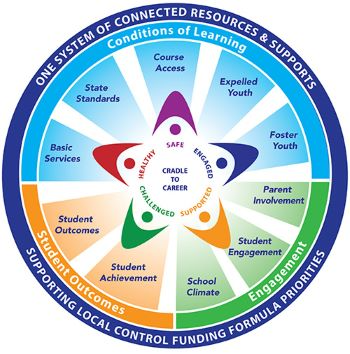District
Schools
Departments
Parents
Employees
Social Emotional Support
What is the LCAP?
The Local Control Accountability Plan (LCAP) is a comprehensive three-year plan, updated annually, outlining the strategies a district intends to implement to enhance student outcomes. Structured around ten priority areas, it is mandated to address the needs of students from diverse backgrounds, particularly those facing socioeconomic challenges, foster youth, and English language learners. The LCAP provides an opportunity for school districts to share their stories of how, what, and why programs and services are selected to meet their local needs. The components of the LCAP are posted as one document assembled in the following order:
LCFF Budget Overview for Parents
Plan Summary
Engaging Educational Partners
Goals and Actions
Increased or Improved Services for Foster Youth, English Learners, and Low-income students
Action Tables
Instructions
What is the purpose of the LCAP?
California's primary education finance law, the Local Control Funding Formula (LCFF), distributes base funding to districts based on student enrollment numbers. Additionally, districts receive supplementary funding per student to support the education of English language learners, foster youth, and economically disadvantaged students.
While districts have flexibility in allocating these funds, they are obligated to maintain transparency regarding expenditures, particularly for targeted student groups. The LCAP serves as the primary tool for districts to ensure this transparency. The State Board of Education provides districts with a standardized template organized around priority areas, which districts are expected to follow or customize to meet their specific needs. Enacted into law in 2014, the LCFF-LCAP system represents a significant legislative achievement during the Brown Administration.
Ensuring Accountability in School Districts
An underlying assumption regarding the LCAP is that community members will engage with it to hold schools accountable for achieving results and using additional funding appropriately. Originally created in 2014, the LCAP Parent Checklist, developed in partnership with the California State PTA, assists parents in understanding and providing informed input into the document.
Community Engagement
The LCAP process provides an opportunity for stakeholders to communicate their priorities to the district. It requires consultation with various groups, including the District Parent Advisory Committee (PAC), English Learner Parent Advisory Committees (DLAC), parents, students, school personnel, local bargaining units, and the community. School site councils and site-based student and parent groups (PTSAs) also play a crucial role in aligning their work with the district's LCAP.

Questions about our LCAP contact: Michael Cubacub, Ed.D. Director of Educational Services Phone Number: 925.625.0700
When must the district's LCAP be completed?
Districts are required to adopt their LCAP as part of their annual budget process, which must be completed by June 30 of each year. In addition, school districts are required to present a mid-year update that includes all available mid-year expenditure and implementation data on all actions identified in the LCAP. The mid-year expenditure and implementation data that an LEA reports to its local governing board is locally determined and must be presented on or before the end of February of each year.
Who approves the LCAP?
The district's school board votes to adopt the LCAP. After approval, the county office of education reviews it and may suggest revisions. Ultimately, the California Department of Education reviews county office LCAPs. Input is crucial early in the process due to the rapid pace of finalization.